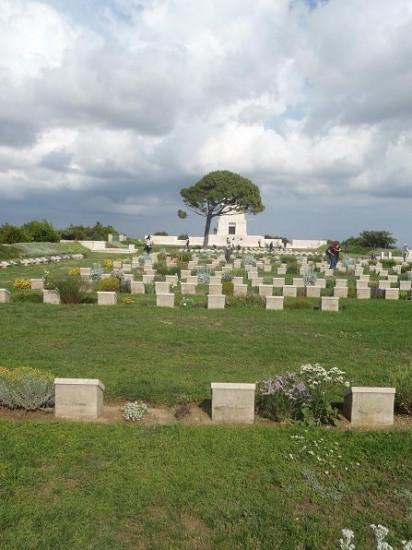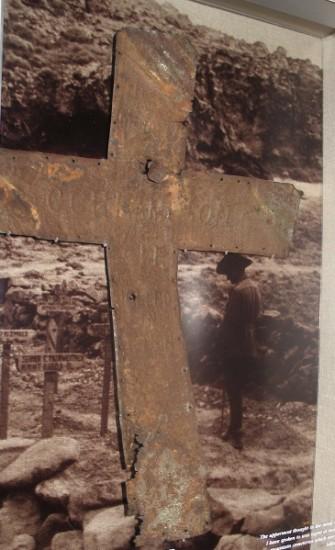A visit to Lone Pine Cemetery

While recently at Lone Pine Cemetery, Gallipoli, I took the opportunity to visit the graves of two men, Corporal David 'Yank' McVay and Private Charles Hampson who served with D Company in the 23rd Battalion. A few years ago I researched their stories while cataloguing the metal cross plates that came from their original graves.
Grave cross made from a biscuit tin: Corporal D McVay, 23 Battalion AIF

In 1915, the plates were attached wooden crosses. Both plates have holes around the edges for nails, showing where they were attached. Unfortunately, the crosses were probably used as fire wood by Turkish soldiers or civilians after the evacuation, as wood was scarce in the area and the crosses were easy to access. Stylistically, Hampson's and McVay's cross plates are very similar, and may have been made by the same person, possibly also a member of D Company, 23rd Battalion. Hampson's cross is currently on display in ANZAC Hall and is more damaged than McVay's - with some bullet or shrapnel holes and some sections torn away.

The plates were found at Gallipoli by Captain Gordon Samuel Keesing in 1919. Keesing was an assistant to the architect, Sir John Burnet and they were visiting Gallipoli to inspect the area as Burnet was designing the permanent cemeteries at Gallipoli for the Imperial War Graves Commission.

1243 Private David McVay was a 32 year old miner from Fitzroy in Melbourne and he enlisted in the AIF on 8 April 1915. He was an original member of D Coy, and embarked from Australia aboard HMAT Euripides on 10 May 1915. McVay was born in England, and had previously served with the Field Artillery in South Africa. He had deserted from the army but was pardoned on King Edward VII's death in 1910.
After a period of training in Egypt, he landed with the 23rd Battalion at Gallipoli on the night of 4 September and was marched to Rest Gully. On 5 September the battalion spent their first night in the front line trenches at Lone Pine. The fighting here was so dangerous and exhausting that battalions were relieved every day. The 23rd Battalion manned Lone Pine, alternating with the 24th Battalion, until they left Gallipoli in December 1915. McVay was promoted to corporal on 9 September. Four days later, he was one of three men from the 23rd Battalion killed at Lone Pine on 13 September. The unit war diary for that day notes that McVay was sniped by a Turk from the unit's right flank. McVay had no known surviving relatives.

743 Private Charles George Hubbard Hampson was a 36 year old driver from Richmond, Victoria when he enlisted in the AIF on 1 March 1915. Like McVay, he was also a member of D Company, 23 Battalion and he landed at Gallipoli on the night of 4 September. Hampson had served at Gallipoli for almost a month when he was was killed on 3 October 1915, at Lone Pine. That day, Turkish artillery were firing from the direction of Scrubby Knoll at the Lone Pine trenches, and it is possible he was killed by a shell. Hampson's Mother died in 1917 and his Father had been dead for many years before that. After the war his sisters chose to put an epitaph on his new headstone which reads "OUR BROTHER THE DEAREST AND BEST EVER FONDLY LOVED AND REMEMBERED".
Both McVay and Hampson were originally buried at Brown's Dip Cemetery, which was near Lone Pine. After the war the cemetery was found to be at major risk from erosion, so in 1923 the bodies were exhumed and reinterred in what became known as the Brown's Dip plot in Lone Pine Cemetery. This is located at the opposite end of the cemetery from the Lone Pine Memorial.

If you have the chance to visit Lone Pine Cemetery and are interested in visiting their graves, McVay and Hampson are both located in Plot 1 of the Brown's Dip Plot, Mc Vay is in Row B grave 15 and Hampson in Row E grave 6.

